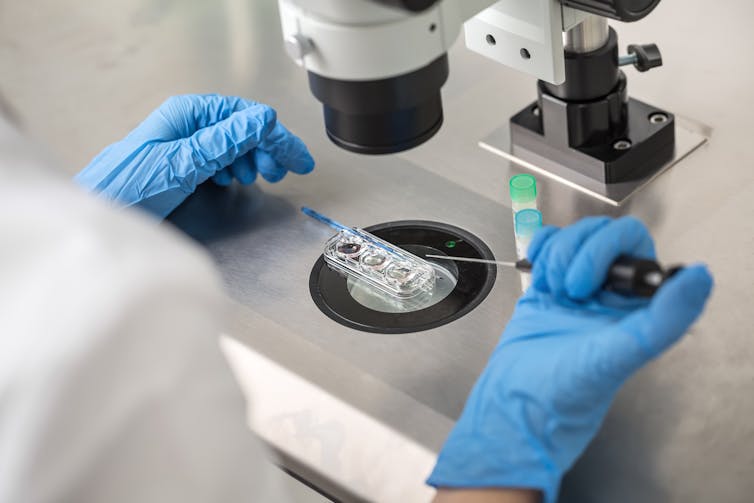Source: The Conversation (Au and NZ) – By Fiona Kelly, Professor, Law School, La Trobe University
The Victorian government’s budget announcement to fund a public egg and sperm bank will be welcomed by couples and single women who need donors to conceive.
The bank will proactively recruit local donors, store donated eggs, sperm and embryos, and develop and deliver education and awareness programs about the need for donations. It will be the first of its kind in Australia, though it is not yet known when it will launch.
At a time when access to sperm and eggs are limited by low supply and high cost, a public donor bank will reduce the number of Victorians turning to potentially risky practices such as informal online donating or reproductive tourism overseas.
If it’s successful, other states and territories experiencing shortages may well follow.
Read more: Meet the men who donate sperm on Facebook
Shortages and high costs
Victorians who need donated sperm and eggs are often faced with limited choice, lengthy wait lists created by donor shortages, and high costs.
When an egg donor is needed, recipients are largely left to their own devices, with most recruiting donors via online platforms.
IVF clinics typically have a greater supply of sperm donors, but wait lists are still common and choices limited. Victorian clinics report COVID-19 has exacerbated the problem, with one reporting a 90% drop in sperm donor inquiries during the pandemic.
The number of men donating sperm to Victorian clinics has actually increased over the past decade. But demand has also increased, particularly since 2008 when it became legal for single and lesbian women to access fertility treatment in Victoria.
By 2019/2020, single women had become the largest group of women treated with donor sperm in Victoria (54%), followed by women in same-sex relationships (32%).

Despite the demand for donated sperm and eggs, private fertility clinics have not been successful in recruiting enough donors.
The other significant barrier to accessing donated eggs is cost. The cost of IVF can reach as much as A$10,000 for the first cycle. While clinics can’t charge for eggs, harvesting the eggs is a major cost of the process. If you eliminate that cost, the price of IVF drops dramatically. While a number of bulk-billing IVF clinics have opened in recent years, none provide donated eggs as part of their services.
What are the risks of alternative methods?
In recent years, and perhaps accelerated by the closure of Australia’s borders due to COVID-19, there has been an increase in unregulated sperm donation through online platforms where men offer their sperm to prospective parents.
This carries health risks because donor aren’t screened for sexually transmitted diseases. Sperm donated to clinics is quarantined for six months and then donors are re-screened for HIV, Hepatitis B and C,and syphilis prior to release for treatment.
There have also been reports of women being pressured by donors to engage in “natural insemination” and even allegations of sexual assault.

While fertility clinics are required by law to limit the number of children born from a single donor, offspring limits cannot be controlled for in the informal market. Offspring limits reduce the risk of accidental incest.
Another issue is donor-conceived children may not have access to their donor’s identity. Clinic donors must agree to have their information on Victoria’s Central Register so their donor offspring have access to their identity.
But it’s impossible to ensure informal donors are registered, or to register the anonymous donors of children conceived overseas where eggs and sperm are more readily available.
Read more: Secrets and lies: why donor-conceived children need to know their origins
How might a public donor egg and sperm bank help?
A public donor egg and sperm bank would focus on recruiting new sperm and egg donors, providing a greater number and range of donor eggs and sperm, at a lower cost.
Importantly, it would reduce reliance on risky informal sperm and egg donation arrangements and reproductive tourism to jurisdictions that provide fewer protections for children.
According to a Deloitte Access Economics feasibility study, for a public donor egg and sperm bank to deliver on its potential benefits, it would need to “orchestrate a social marketing campaign that speaks to the value of donation and seeks to influence social views on donation”.
Successful campaigns in other areas, such as blood, plasma and breastmilk donation, have demonstrated that while changing community attitudes can take time, such campaigns can yield positive results.
Read more: Breast milk banking continues an ancient human tradition and can save lives
Creating a positive donor experience, emphasising the importance of altruistic donation, the introduction of structural changes such as out-of-hours services, and the provision of adequate resources to support a sophisticated recruitment campaign, will be essential to the bank’s success.
– ref. Victoria’s egg and sperm bank will reduce the risks of seeking donors online. Here’s why it’s needed – https://theconversation.com/victorias-egg-and-sperm-bank-will-reduce-the-risks-of-seeking-donors-online-heres-why-its-needed-161414








